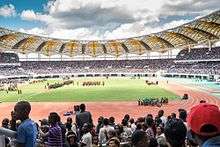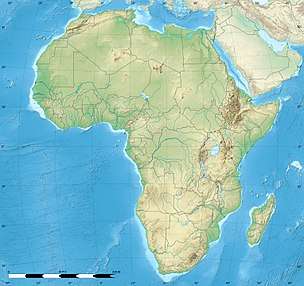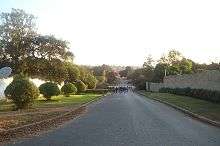Lusaka
Lusaka (/luːˈsɑːkə/ loo-SAH-kə) is the capital and largest city of Zambia. It is one of the fastest developing cities in southern Africa. Lusaka is in the southern part of the central plateau at an elevation of about 1,279 metres (4,196 ft). As of 2010, the city's population was about 1.7 million, while the urban population is estimated at 2.5 million in 2018.[5] Lusaka is the centre of both commerce and government in Zambia and connects to the country's four main highways heading north, south, east and west. English is the official language of the city administration, while Nyanja and Bemba are the commonly spoken street languages.
Lusaka Mwalusaka | |
|---|---|
City | |
  From top: Lusaka city at Night, Downtown Lusaka, Lusaka National Museum, Inauguration of Edgar Lungu | |
 Lusaka Location of Lusaka in Zambia  Lusaka Lusaka (Africa) | |
| Coordinates: 15°25′S 28°17′E | |
| Province | Lusaka Province |
| District | Lusaka District |
| Country | |
| Established | 1905 |
| City status | 25 August 1960 |
| Government | |
| • Mayor of Lusaka | Miles Sampa |
| Area | |
| • City | 418 km2 (161 sq mi) |
| Elevation | 1,279[2] m (4,190 ft) |
| Population (2010) | |
| • City | 1,747,152[3] |
| • Metro | 2,238,569 |
| Time zone | UTC+2 (CAT) |
| Area code(s) | 0211[4] |
| Climate | Cwa |
| Website | http://www.lcc.gov.zm |
History

Lusaka was the site of a village named after its Chief Lusaka, which, according to history, was located at Manda Hill, near where the Zambia's National Assembly building now stands. In the Nyanja language, Manda means "graveyard." The area was expanded by European (mainly British) settlers in 1905 with the building of the railway. [6][7]
In 1935, due to its fairly central location, its situation on the railway and at the crossroads of the Great North Road and Great East Road, it was chosen to replace Livingstone as the capital of the British colony of Northern Rhodesia.[8][9]
After the federation of Northern and Southern Rhodesia in 1953, it was a centre of the independence movement amongst some of the educated elite that led to the creation of the Republic of Zambia. In 1964, Lusaka became the capital of the newly independent Zambia.[8]
In recent years, Lusaka has become a popular urban settlement for Zambians and tourists alike. Its central nature and fast growing infrastructure sector have increased donor confidence and as such Zambians are seeing signs of development in the form of job creation, housing, etc. Consequently, it is thought that with proper and effective economic reforms, Lusaka as well as Zambia as a whole will develop considerably. Lusaka is home to a diverse community of foreign nationals, many of whom work in the aid industry as well as diplomats, representatives of religious organisations and some business people.[8]
| Historical population | ||
|---|---|---|
| Year | Pop. | ±% |
| 1990 | 769,353 | — |
| 2000 | 1,084,703 | +41.0% |
| 2010 | 1,747,152 | +61.1% |
| 2018 | 2,526,100 | +44.6% |
| 2019 | 3,308,400 | +31.0% |
| source:[10] | ||
Government

As the national capital, Lusaka is the seat of the legislative, executive and judicial branches of government, epitomized by the presence of the National Assembly (parliament), the State House (office of the President), and the High Court. The Parliament is situated at the Parliament complex, which features a 15-story building. The city is also the capital of Lusaka Province, the smallest and most populous of the country's nine provinces, and forms an administrative district run by Lusaka City Council. In 2007, the mayor was Steven Chilatu (PF), and the deputy mayor was Mary Phiri.
List of mayors:[11]
- F. Payne 1954–55.
- H. K. Mitchell 1955–56
- Ralph Rich 1956–57
- H. F. Tunaley 1957–58
- H. K. Mitchell 1958–60
- Jack Fischer 1960–61
- Richard Sampson 1962–63
- S. H. Chilesh 1964–65
- W. Banda 1965–69
- Fleefort Chirwa 1969–71?[12]
- Simon C. Mwewa up to 1982
List of Governors (decentralisation – one party participatory era)
- Simon C. Mwewa 1982 to 1983
- Donald C. Sadoki
- Michael Sata
- Rupiah Banda
- Bautius Kapulu
- Lt. Muyoba – up to 1991
List of Mayors – Multi-party era
- John Chilambwe 1993–94
- Fisho Mwale 1994–96
- Gilbert R. Zimba Local Government Administrator – 1996–99
- Patricia Nawa
- Patrick Kangwa
- John Kabungo
- Levy Mkandawire
- Stephen Mposha
- Christine Nakazwe
- Stephen Chilatu
- Robert Chikwelete
- Daniel Chisenga
- Mulenga Sata
- Wilson Chisala Kalumba – 2016 – May 2018 (died in office)
- Miles Sampa – July 2018 – present
Education

Zambia's largest institution of learning, the University of Zambia, is based in Lusaka. Other universities and colleges located in Lusaka include: University of Lusaka (UNILUS), Zambian Open University (ZAOU), Chainama Hills College, Evelyn Hone College of Applied Arts and Commerce, Zambia Centre for Accountancy Studies University (ZCASU), National Institute of Public Administration (NIPA), Cavendish University, Lusaka Apex Medical University and DMI-St. Eugene University. Lusaka has some of the finest schools in Zambia, including the American International School of Lusaka, Rhodes Park School, the Lusaka International Community School, the French International School, the Italian international School, the Lusaka Islamic Cultural and Educational Foundation (LICEF), the Chinese International School, Lusaka Russian Embassy School[13], and Baobab College. Rhodes Park School is not an international school, though there is a large presence of Angolans, Nigerians, Congolese, South Africans, and Chinese. The children of the late President, Levy Mwanawasa as well as the children of late Vice-President George Kunda, attend the Rhodes Park School. Other well known schools located in Lusaka include: Matero Boys' Secondary School (MaBoys), Roma Girls' Secondary School, Munali Boys' and Girls' Secondary Schools, Chudleigh House School, Kabulonga Boys' and Girls' Secondary Schools, Lake Road PTA School, David Kaunda Technical School (DK), Ibex Hill School and St. Mary's Secondary School.
Residential Areas & Townships
- Kabulonga [14]
- Woodlands
- Rhodes Park [15]
- Northmead
- Emmasdale
- Villa Elizabetha
- Thornpark
- Olympia Park
- Roma
- Foxdale
- Sunningdale
- Madras
- PHI
 Street in PHI, Lusaka.
Street in PHI, Lusaka. - Avondale
- Kamwala
- Kabwata
- Libala
- Chilenje
- Chelstone
- Kaunda Square
- Munali
- Nyumba Yanga
- New Kasama
- Chalala
- Kanyama[16]
- John Laing
- Makeni
- Misisi
- Chawama
- Kalingalinga
- Mtendere
- Bauleni
- Chibolya
- Kabanana
- Chilenje South
- Chazanga
- George
- Matero [17]
Places of worship

Among the places of worship, they are predominantly Christian churches and temples : Roman Catholic Archdiocese of Lusaka (Catholic Church), United Church in Zambia (World Communion of Reformed Churches),New Apostolic Church, Reformed Church in Zambia (World Communion of Reformed Churches), Baptist Union of Zambia (Baptist World Alliance), Assemblies of God. [18] There are also Muslim mosques.
Culture
Attractions include Lusaka National Museum, the Political Museum, the Zintu Community Museum, the Freedom Statue, the Zambian National Assembly, the Agricultural Society Showgrounds (known for their annual agricultural show), the Moore Pottery Factory, the Lusaka Playhouse theatre, Manda Hill Shopping Mall, Arcades Shopping Mall, East Park Shopping Mall, a cenotaph, Lusaka Golf Club, National Heroes Stadium, Woodlands Stadium, the Lusaka Central Sports Club, Kalimba Reptile Park, Mulungushi Conference Centre, Monkey Pools and the zoo and botanical gardens of the Munda Wanga Environmental Park.
Architecture
Along Great East Road are three of the largest shopping malls in Zambia: Arcades shopping mall (with open-air storefronts), East Park shopping mall and Manda Hill shopping mall (enclosed shops),[19] which was revamped and is home to international stores such as Shoprite, Game and Woolworths, Fresh View Cinemas and many others.


The city centre includes several blocks west of Cairo Road, around which lie the New City Market and Kamwala Market, a major shopping area, as well as the Zintu Community Museum. Further east lies the government area, including the State House and the various ministries, around Cathedral Hill and Ridgeway neighbourhoods. One of the main streets and points of interest upon business is Cairo Road.
Transport

Airport
Lusaka is home to Kenneth Kaunda International Airport (which is used for both civil and military operations). There is also Lusaka City Airport, which is used by the Zambian Air Force. The airport is currently undergoing a major expansion and modernisation.
Rail
The city is served by the operating sections of the Cape to Cairo Railway, which connects it to Lubumbashi and Bulawayo. The international airport is connected to the railway line.
Road
The city is crossed by Transafican Highway 9 (TAH 9), which connects it to the cities of Harare and Lubumbashi, and by Transafrican Highway 4 (TAH 4), which connects it to Dodoma and Bulawayo.
Public transport
Intracity public transport is provided primarily by minibuses, but also includes larger buses and shared taxis on fixed routes.[20] Vehicles on most routes travel between specific parts of the city and the four terminals in the central business district (referred to as "Town"): Kulima Tower, City Market, Millennium and Lumumba.[21] There is no official map of public transport routes in Lusaka, but an initiative to create a user-generated content map was begun in 2014.[22] All public transport vehicles in Lusaka are operated by private operators.
Sport
As the hosts of the 2012 Zone VI Games and the capital city of Zambia, Lusaka boasts extensive sports infrastructure, including Nkholoma Stadium in Chelstone, Sunset Stadium along Thabo Mbeki Road, Woodlands Stadium in Woodlands Residential Area, the Olympic Youth Development Centre (OYDC) along Great North Road, the Lusaka Golf Club in Chainama Hills and many other places. The city's ultra-modern 60,000 seat stadium, built by China, is named the National Heroes Stadium in memory of the Chipolopolo national team football players who died in a plane crash off the coast of Gabon in 1993.[23] The stadium was completed by the end of 2013 and since then has hosted most of the Zambia National Football team's international matches, local club matches, Zambia's 50th Year Golden Jubilee Celebrations and a Requiem Mass for the late President of Zambia, Michael Sata.
International relations
Lusaka is twinned with:





Notable people

The rugby union players Corné Krige and George Gregan, who respectively captained the South African and Australian teams in both the 2002 and 2003 Tri Nations Series, were coincidentally born in the same hospital in Lusaka.[24][25][26]
The former Zimbabwe cricketer Henry Olonga was also born in Lusaka. He was the first black cricketer – and the youngest person – to play for Zimbabwe.[27]
Lusaka is the hometown and current place of residence of Joseph and Luka Banda, the first conjoined twins to be successfully separated and in full neurological health.[28]
Climate
Primarily due to its high altitude, Lusaka features a humid subtropical climate (Cwa) according to Köppen climate classification. Its coldest month, July, has a monthly mean temperature of 14.9 °C (58.8 °F). Lusaka features hot summers and warm winters, with cold conditions mainly restricted to nights in June and July. The hottest month is October, which sees daily average high temperatures at around 32 °C (90 °F). There are five distinct seasons: a monsoonal period (mid-November to March) when high humidity and heavy rainfall occurs, Autumn (April-May) features mild weather and a decrease in rainfall, Winter (June-July) has cold nights and sunny weather, Spring (August-September) results in an increase in temperatures, and Summer (October to mid-November) brings in early rains before the monsoon starts.
| Climate data for Lusaka | |||||||||||||
|---|---|---|---|---|---|---|---|---|---|---|---|---|---|
| Month | Jan | Feb | Mar | Apr | May | Jun | Jul | Aug | Sep | Oct | Nov | Dec | Year |
| Record high °C (°F) | 39.6 (103.3) |
36.4 (97.5) |
33.6 (92.5) |
33.0 (91.4) |
32.0 (89.6) |
29.9 (85.8) |
29.7 (85.5) |
33.5 (92.3) |
38.5 (101.3) |
37.2 (99.0) |
38.6 (101.5) |
33.9 (93.0) |
39.6 (103.3) |
| Average high °C (°F) | 27.4 (81.3) |
27.4 (81.3) |
27.5 (81.5) |
27.1 (80.8) |
25.8 (78.4) |
23.8 (74.8) |
24.0 (75.2) |
26.5 (79.7) |
30.3 (86.5) |
31.7 (89.1) |
30.4 (86.7) |
27.7 (81.9) |
27.5 (81.5) |
| Daily mean °C (°F) | 21.5 (70.7) |
21.5 (70.7) |
21.1 (70.0) |
19.9 (67.8) |
17.4 (63.3) |
15.2 (59.4) |
14.9 (58.8) |
17.3 (63.1) |
21.3 (70.3) |
23.5 (74.3) |
23.4 (74.1) |
21.7 (71.1) |
19.9 (67.8) |
| Average low °C (°F) | 17.6 (63.7) |
17.4 (63.3) |
16.4 (61.5) |
14.0 (57.2) |
10.7 (51.3) |
7.8 (46.0) |
7.2 (45.0) |
9.2 (48.6) |
12.9 (55.2) |
16.2 (61.2) |
17.4 (63.3) |
17.8 (64.0) |
13.7 (56.7) |
| Record low °C (°F) | 13.0 (55.4) |
12.9 (55.2) |
10.0 (50.0) |
8.0 (46.4) |
5.4 (41.7) |
0.2 (32.4) |
0.7 (33.3) |
2.8 (37.0) |
5.8 (42.4) |
9.0 (48.2) |
10.8 (51.4) |
10.4 (50.7) |
0.2 (32.4) |
| Average precipitation mm (inches) | 245.4 (9.66) |
185.9 (7.32) |
95.0 (3.74) |
34.7 (1.37) |
3.1 (0.12) |
0.0 (0.0) |
0.1 (0.00) |
0.4 (0.02) |
1.7 (0.07) |
18.4 (0.72) |
89.3 (3.52) |
208.1 (8.19) |
882.1 (34.73) |
| Average precipitation days (≥ 1.0 mm) | 18 | 15 | 10 | 3 | 0 | 0 | 0 | 0 | 0 | 2 | 8 | 16 | 72 |
| Average relative humidity (%) | 82.3 | 82.5 | 80.7 | 75.8 | 69.3 | 65.2 | 61.1 | 53.6 | 46.3 | 48.6 | 60.2 | 78.6 | 67.0 |
| Mean monthly sunshine hours | 176.7 | 168.0 | 220.1 | 246.0 | 275.9 | 270.0 | 294.5 | 303.8 | 291.0 | 272.8 | 234.0 | 182.9 | 2,935.7 |
| Source: NOAA[29] | |||||||||||||
See also
- Southern Africa Freedom Trail
- Kafue Railway Bridge (Railway bridge from Livingstone to Lusaka)
- Komboni
References
- City of Lusaka Website Archived 20 April 2012 at the Wayback Machine
- Airport altitude, http://climexp.knmi.nl/ Retrieved 7 March 2015
- http://citypopulation.de/Zambia-Cities.html
- <%=hdrContact%>. "Zambia". www.itu.int. Archived from the original on 15 September 2017. Retrieved 2 May 2018.
- "Zambia Population 2020 (Live)". worldpopulationreview.com. Retrieved 28 April 2020.
- Roman Adrian Cybriwsky, Capital Cities around the World: An Encyclopedia of Geography, History, and Culture, ABC-CLIO, USA, 2013, p. 167
- Mwakikagile, Godfrey (2010). Zambia: Life in an African Country. New Africa Press. p. 158. ISBN 9789987160112. Archived from the original on 2 May 2018.
- Mwakikagile, Godfrey (2010). Zambia: Life in an African Country. New Africa Press. p. 159. ISBN 9789987160112. Archived from the original on 2 May 2018.
- Britannica, Lusaka, britannica.com, USA, accessed on 30 June 2019
- Lusaka population statistics
- So this was Lusaakas, 2nd Edition, 1971 Mission Press, Ndola, Richard Sampson
- "Los Angeles honors mayor of sister city in Africa". Jet. 10 August 1972. Retrieved 14 May 2013.
- "Russian Embassy School, lusaka, Zambia". bizpages.org. Retrieved 24 February 2020.
- https://www.zambiatourism.com/towns/lusaka/city-map/
- https://www.google.com/maps/place/Lusaka/@-15.4084095,28.2788306,15.2z/data=!4m5!3m4!1s0x1940f37d3cbcaa49:0xd0d093c1462013eb!8m2!3d-15.3875259!4d28.3228165
- https://www.google.com/maps/place/Kanyama,+Lusaka/@-15.4365722,28.1996717,13z/data=!3m1!4b1!4m5!3m4!1s0x1940f3afd4671d6b:0x979ffb71c608b72b!8m2!3d-15.4368124!4d28.2351192
- https://www.google.com/maps/place/Matero,+Lusaka/@-15.377142,28.2464396,14z/data=!3m1!4b1!4m5!3m4!1s0x1940f5a2f971faab:0xe5030f49d59ca342!8m2!3d-15.3773823!4d28.2614332
- Britannica, Zambia, britannica.com, USA, accessed on 7 July 2019
- Mwakikagile, Godfrey (2010). Zambia: Life in an African Country. New Africa Press. p. 161. ISBN 9789987160112. Archived from the original on 13 November 2017.
- "Can You Do It? Using Public Transportation in Lusaka Zambia". Travel Wanderings. 5 September 2013. Archived from the original on 28 May 2014. Retrieved 26 May 2014.
- "Making Public Transport in Lusaka City More Efficient and Effective" (PDF). Zambia Institute for Policy Analysis & Research. December 2013. Archived from the original on 28 May 2014. Retrieved 10 March 2014.
- "And We Have a Map!". Lusaka Public Transport Map: A User-Generated Mapping Project. 10 March 2014. Archived from the original on 27 May 2014. Retrieved 26 May 2014.
- Muchimba, Jerry (28 May 2015). Godfrey 'Ucar' Chitalu. Troubador Publishing Ltd. p. 213. ISBN 9781784622206. Archived from the original on 19 August 2017.
- "George Gregan - Player Profile". Georgegregan.com. Archived from the original on 9 November 2008. Retrieved 13 November 2008.
- "Captain Courageous: Corné Krige" Archived 26 July 2011 at Wikiwix, TheGoal.com, retrieved 26 June 2006.
- "Rugby Union World Cup Special Reports: South Africa" Archived 19 January 2008 at the Wayback Machine, The Guardian, 6 October 2003.
- "Henry Olonga- a short biography". ESPNcricinfo. 18 September 1999. Retrieved 4 September 2018.
- Terris, Ben; Kirchner, Stephanie (13 November 2015). "The Story of the Surgery that made Ben Carson Famous". Washington Post. Retrieved 14 November 2015.
- "LUSAKA INTERNATIONAL AIRPORT Climate Normals 1961-1990". National Oceanic and Atmospheric Administration. Retrieved 6 November 2012.
Bibliography
External links
| Wikimedia Commons has media related to Lusaka. |

- Lusaka City Council
- Zambia Tourism page on Lusaka
